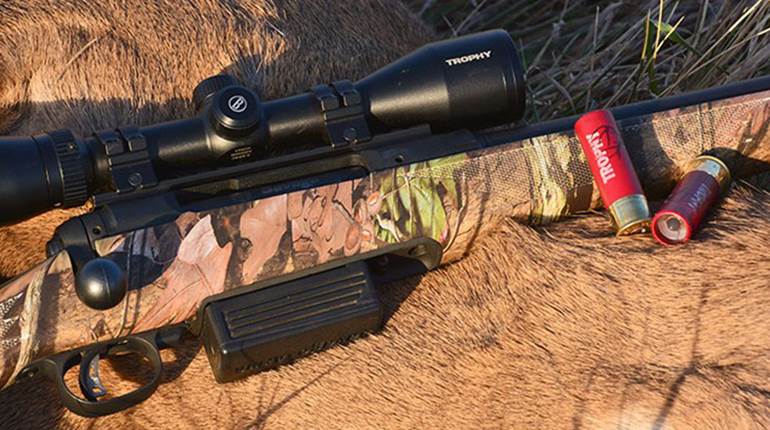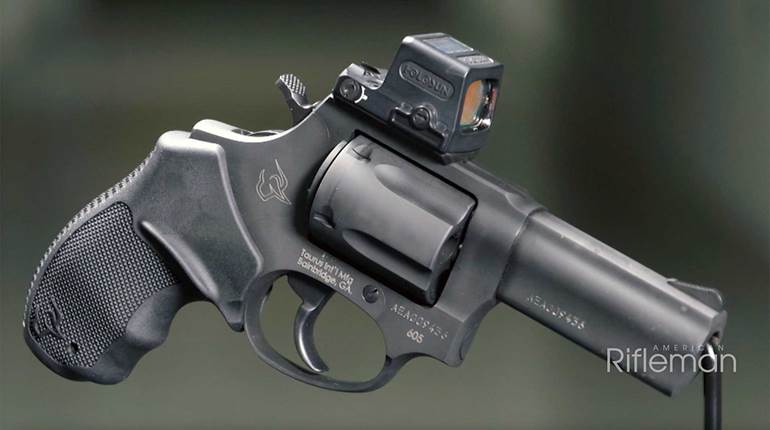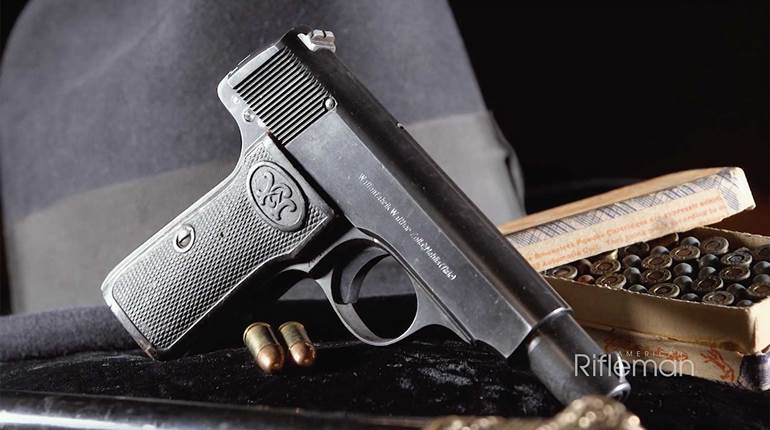
9/18/2012
Kel-Tec has been innovative not only in how it designs and manufactures its firearms, but it also has challenged convention in the appearance and styling of its handguns and center-fire rifles. With its KSG, the firm has turned that focus to shotguns.
To say the Kel-Tec Shotgun (KSG) looks unconventional is an understatement. How often do you see a bullpup 12-gauge shotgun—the trigger and pistol grip forward of the action—with two separate but equal magazines? Considering the interest it produced both at SHOT Show and at the NRA Annual Meetings & Exhibits earlier this year, Kel-Tec’s first entry into shotgun making—despite having a slow start in terms of delivery—was a winner right out of the gate.
Similar in appearance to Kel-Tec’s innovative RFB rifle, the pump-action 12-gauge KSG has a magazine capacity of either 14 2 3/4- or 12 3-inch shotshells when fully loaded. It weighs almost 7 pounds unloaded and 8 pounds, 8 ounces fully loaded. The shotshells are loaded into two parallel, tubular magazines below the 18-inch barrel with each tube holding seven 2 3/4- shells (or six 3-inch shells). A lever at the tubes’ rear, just below the chamber behind the pistol grip, determines which magazine tube feeds the gun. This allows the user to select specific loads, depending on the task.
By choosing the middle position, the three-position switch also acts as a magazine block, allowing the chamber to be emptied while shells remain in the magazines. A single shotshell, such as a slug, can then be inserted into the chamber by pushing a cartridge against the ejector/follower. While the practical application of such a system may be limited, it is nonetheless a nice feature to have. Most users will simply turn the gun upside down, push the selector lever to one side and load seven shells into the first magazine before flipping the lever to repeat the process with the other magazine. The gun is neither easy nor fast to reload. With practice the user can efficiently add shells to the magazine without turning the gun over, but the KSG remains slower to load than other more conventional shotguns.
The bolt has a pivoting block that locks into an extension at the rear of the barrel. As the dual-action-bar slide is pulled, a hook extractor at the bottom of the bolt removes the shell from the chamber so the combination ejector/cartridge follower can push it out through the bottom loading and ejection port before picking up another shell from the magazine and raising it to the chamber.
The stock is made of glass-reinforced nylon, while the receiver is 4140 steel with the magazine tubes welded in place underneath the barrel. Both the polymer pistol grip and the fore-end are textured to enhance purchase, with the fore-end surrounding the barrel and magazine tubes. The latter have cutouts for viewing remaining ammunition. The manual safety is of the cross-bolt variety, is designed to be controlled with the thumb and forefinger, and has large, easily viewable letters (“F” in red for fire and “S” in white for safe) indicating whether it is on or off.
The gun comes with a 12-inch-long piece of Picatinny rail on top for mounting optics or sights, neither of which are included, along with a 6-inch rail for flashlights, lasers or vertical grips. The chamber is chromed, and the KSG will eventually come with interchangeable screw-in choke tubes, but the test model had an improved cylinder bore. Kel-Tec claims that both OD green and coyote tan will be available on the KSG—as well as a Cerakote finish—but solid black was all that was available at the time of testing.
Although the KSG appears complicated, disassembly is actually quite simple. The shotgun breaks down into four basic components for cleaning, and the fore-end can also be removed if necessary. After ensuring that the gun is unloaded, remove the disassembly pins in the buttstock (there are two holes in the pistol grip for storing them). From there, pull the grip assembly off the gun. Then, remove the rear stock by pulling it straight out before taking out the bolt by slightly pulling the slide and lifting the bolt out of the chamber. At that point, cleaning is possible, but to continue, use a coin or large screwdriver to unscrew the caps on the front of the magazines (alternating the rotation a half-turn at a time) and pull off the fore-end. Kel-Tec does not recommend anyone but a Kel-Tec technician go further.
Reassembly is in reverse except for the bolt. To replace the bolt, pull the slide fully to the rear and insert the bolt sideways from the rear, rotating it to align the slots. It does require a bit of angling to make it fit, but it’s not difficult. Once the bolt is in the gun, pull the slide forward while listening for an audible click to ensure proper placement. Then replace the remaining components on the gun.
Since the KSG doesn’t come with sights, I mounted a Leupold Prismatic 1X 14 mm scope with illuminated reticle, and for good measure I added a vertical foregrip and a Lasermax Genesis rechargeable green laser. Those extras added weight, and the fully loaded and fully equipped Kel-Tec as tested tipped the scale at 10 pounds, 4 ounces.
Shooting began with Remington AccuTip 385-grain bonded sabot slugs to sight-in both the optic and laser. Formal accuracy tests were conducted with the AccuTips and Winchester Dual Bond 375-grain sabot slugs, both which are intended principally for rifled bores, a feature which the KSG does not have. In five consecutive, five-shot groups the AccuTip averaged 3.91 inches with a 2.81-inch best group, while the Winchester averaged 3.22 inches with a 2.59-inch best group. Considering the lack of magnification in the optic, the groups showed more than enough accuracy for self-defense purposes, ensuring a powerful hit on center of mass. These groups were especially nice since the KSG’s trigger measured 8 pounds, 2 ounces, the somewhat heavy weight of which is a by-product of the gun’s bullpup configuration. Closer ranges turned the groups into big ragged holes with both the Leupold and the laser.
At 25 yards, Hornady’s Critical Defense 00 buckshot loads provided excellent patterns with most of the pellets centering inside a 12-inch circle. I also took the KSG on the skeet field to determine the gun’s effectiveness on moving targets. With the KSG, I was able to hit 17 and 18 out of 25 clays in two rounds (I even doubled on a couple of true pairs), which is right on par with my abilities with a more conventionally stocked shotgun. Even though the short barrel didn’t swing like a standard-configuration shotgun, moving targets—such as those encountered in practical competition—proved no more challenging than usual.
Functionally, the KSG handled almost everything it was fed. In more than 250 rounds fired, there were two failure-to-eject issues, and Federal’s Gold Medal paper hull target loads failed to feed because they kept catching on the chamber rim, deforming the paper hull and preventing the shell from fully entering the chamber. The two failures to eject with plastic-hulled shells occurred during pattern testing with the KSG resting on a Caldwell Lead Sled without my hand on the foregrip. When I held the foregrip tight—as opposed to just letting the fore-end rest on the Lead Sled’s front—the issue did not occur again. Everything else put through the gun—while the fore-end was firmly held—fed, fired and ejected with ease. I ascribe the two issues to error in technique.
At just under $900, the KSG is not inexpensive, nor is it cheaply made. It is emblematic of Kel-Tec’s outside-the-box thinking, a mix of metal and polymer that is both practical and reliable. While its main intended purpose is self-defense, it is suitable for some forms of practical competition, such as 3-gun, and makes for a fun day at the range.
Manufacturer: Kel-Tec CNC Industries, Inc.; (321) 631-0068; www.keltecweapons.com
Action Type: pump-action repeating shotgun
Gauge: 12, 2¾" and 3"
Trigger: single-stage, 8-lb., 2-oz. pull
Magazine: dual tubular; 14-round (2¾") or 12-round (3") capacity
Barrel Length: 181/2"
Sights: none; top Picatinny rail for optics or sights
Overall Length: 26.1"
Height: 7"
Weight: 6 lbs., 15 ozs.
Stock: bullpup; length of pull, 13½"; drop at heel, 0"; drop at comb, 0";
Accessories: shoulder strap, manual,
Suggested Retail Price: $880






































